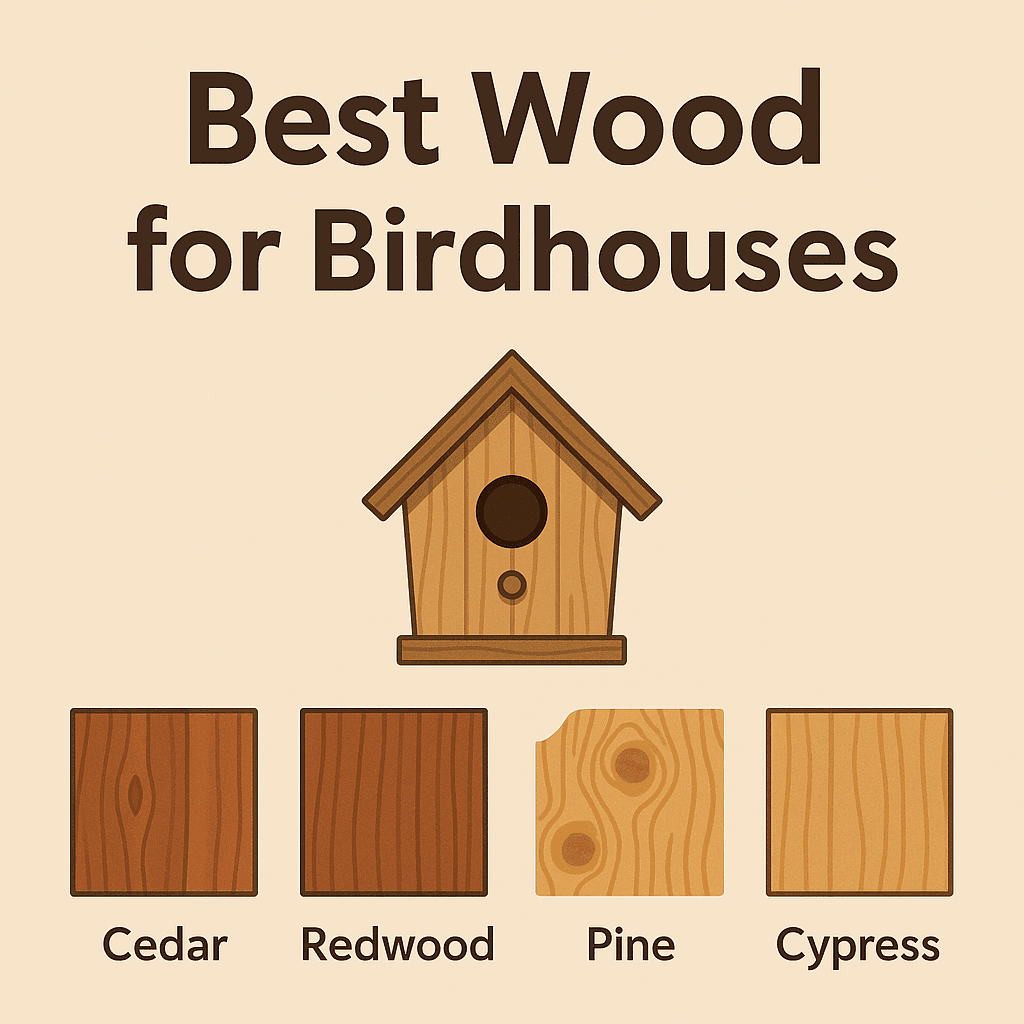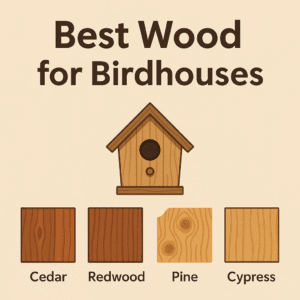The Best Wood for Birdhouses: A Carpenter & Conservationist’s Guide

In my workshop, the scent of freshly cut Western Red Cedar is the smell of hope. It’s the smell of a new beginning, of a structure that, with a little luck, will soon hold the fragile promise of new life. I’ve been building birdhouses for over two decades, not just as a hobby, but as a core part of my conservation work. In that time, I’ve worked with nearly every type of wood imaginable, from cheap pine and reclaimed pallet wood to exotic hardwoods. And I’ve learned a crucial, immutable lesson: the material matters more than the design.
Early on, I built a dozen birdhouses from some scrap plywood I had lying around. They looked great, and I was proud of my resourcefulness. I installed them on a bluebird trail I was managing. That summer, a heatwave hit, and I lost two entire broods. The plywood boxes, with their glue-laden layers and poor insulation, had become solar ovens. It was a heartbreaking and humbling experience. That failure taught me that a birdhouse isn’t a piece of garden furniture; it’s a piece of life-support equipment. The wood you choose has a direct impact on thermoregulation, moisture control, and predator resistance—the very factors that determine whether a nest will succeed or fail.
This guide is the culmination of those decades of hands-on experience, both in the workshop and in the field. We are going to take a deep dive into the world of wood, exploring the absolute best choices for your birdhouse projects and, just as importantly, the common but dangerous materials you must avoid. This is the definitive guide for anyone who wants to build or buy a birdhouse that is not just attractive, but fundamentally safe and effective.
The Best Wood for Birdhouses: The Short Answer
The best woods for birdhouses are natural, untreated softwoods that are naturally resistant to rot and decay, and provide excellent insulation. The goal is to choose a wood that is durable, safe, and breathable.
- The Gold Standard: Cedar (Western Red Cedar is best).
- Excellent Alternatives: Redwood, Cypress, and high-quality Pine (White Pine is a good choice).
- Key Characteristics: Must be untreated, solid wood (not a composite), and at least 3/4-inch thick for proper insulation.
- Woods to AVOID: Plywood, OSB, MDF, particleboard, and any pressure-treated lumber.
Why Wood? The Original and Best Material
Before we compare different types of wood, it’s worth asking why wood is the superior material in the first place. Birds that use birdhouses are known as cavity-nesters. For millions of years, their preferred nesting site has been a hole in a tree, excavated by a woodpecker. A wooden birdhouse is the closest artificial approximation of this natural cavity.
- Excellent Insulation: Wood is a fantastic natural insulator. A thick wooden wall helps keep the nest cool on hot days and warm on cold nights, a critical factor for egg viability and nestling survival.
- Natural Grip: The interior surface of an unpainted wooden birdhouse provides the rough texture that fledglings need to grip with their feet to climb out of the box.
- Breathability: Wood naturally “breathes,” allowing a small amount of moisture vapor to pass through, which helps to prevent condensation and keep the nest dry.
- Familiarity: It looks, feels, and even smells right to a bird. An unpainted cedar box is a far more familiar object to a prospecting bluebird than a plastic or metal one.
The Champions: The Best Woods for Your Birdhouse
These woods represent the pinnacle of performance, offering the perfect blend of durability, safety, and insulation.
1. Cedar (Western Red Cedar): The Unrivaled Gold Standard
If you can only choose one wood, make it Cedar. Western Red Cedar, in particular, is the perfect birdhouse material. It contains natural oils and tannins (like thujaplicin) that make it incredibly resistant to rot, decay, and insect infestation. This means a cedar birdhouse can last for decades without any paint or chemical treatments. It’s lightweight yet strong, and its porous structure gives it a thermal insulation value superior to most other woods. It’s easy to work with, dimensionally stable (meaning it doesn’t warp or twist easily), and weathers to a beautiful silvery-gray. All the high-end, expert-approved birdhouses you’ll find, like those in our birdhouse reviews, are typically made of cedar. It’s a premium material with a premium price, but its longevity makes it a worthwhile investment.

For the Builder: Western Red Cedar Boards
If you’re building your own birdhouse, starting with the right lumber is everything. These high-quality Western Red Cedar boards are the perfect raw material. They are smooth-planed, kiln-dried, and a full 3/4-inch thick, providing the insulation that birds need. Buying a few of these boards will give you enough material to build a birdhouse that will last for 20 years or more. This is the exact type of lumber I use for my own conservation projects. It’s an investment in a final product that is both beautiful and biologically perfect.
Check Price on Amazon2. Redwood: The West Coast Champion
Redwood is very similar to cedar in its properties. It is rich in tannins that make it naturally resistant to decay and insects. It is dimensionally stable and provides excellent insulation. It’s a fantastic choice for a long-lasting, high-quality birdhouse. The main considerations are cost and availability. Redwood is primarily harvested on the West Coast, making it more expensive and harder to find in the eastern United States. If you live in California or the Pacific Northwest, it’s a superb local option. Be sure to source it from sustainably managed forests.
3. Cypress: The Southern Gem
Cypress is another excellent choice, particularly for those in the southern and southeastern United States where it grows natively. Like cedar and redwood, cypress contains a natural preservative oil called cypressene, which makes it very resistant to rot and insects, especially in damp climates. It’s a very durable and weather-resistant wood. The grain is beautiful, and it provides good insulation. Cypress can be a more affordable alternative to cedar in the regions where it’s commonly found.
4. Pine (With a Caveat): The Budget-Friendly Workhorse
Pine is by far the most affordable and widely available wood, making it a very popular choice. However, not all pine is created equal. Pine does NOT have the natural rot resistance of cedar or cypress. This means a pine birdhouse, if left untreated, will likely only last 3-5 years before it starts to decay.
To make a pine house last, it **must be protected with a bird-safe paint or sealer**. We cover this in-depth in our guide to the Best Paint for a Wooden Birdhouse. When choosing pine lumber, opt for a high-quality board like Eastern White Pine with few knots. Despite its shorter lifespan if left untreated, a well-built pine birdhouse that is properly maintained and painted can still be a very effective and economical choice.

The Best Pre-Built Option: Nature’s Way Cedar Bluebird Box
If you’d rather buy than build, this birdhouse from Nature’s Way is a perfect example of using the right material. It’s made from thick, rot-resistant cedar, requiring no paint. It embodies all the principles of a safe design: proper ventilation, drainage, no perch, and an easy-to-open side for cleaning. As we detail in our guide on how to clean a birdhouse, easy access is a must. This is a house designed by experts who understand the importance of material selection. It’s a purchase that will last for many successful nesting seasons.
Check Price on AmazonThe Rogues’ Gallery: Woods and Materials to AVOID at All Costs
This is just as important as knowing what to use. Many common building materials are dangerous for birds and should never be used for a birdhouse.
✓ The Best Choices
- Cedar: Naturally rot-resistant, great insulator, durable.
- Redwood: Similar to cedar, excellent durability and rot resistance.
- Cypress: Very rot-resistant, great for damp climates.
- Pine: Affordable and available, but requires a safe paint/sealer for longevity.
✗ The Worst Choices
- Pressure-Treated Wood: This wood is infused with chemicals like copper and fungicides to prevent rot. These chemicals are toxic and can be lethal to birds. Never use it.
- Plywood/OSB/Particleboard: These are composite materials made with wood chips/sheets and a lot of glue. The glues contain formaldehyde and other toxic chemicals that can off-gas into the nesting chamber. They also absorb water, delaminate, and provide very poor insulation.
- Wood with a Pallet Stamp (HT vs. MB): Reclaimed pallet wood is popular, but you must know what the stamp on the pallet means. Pallets stamped with “HT” have been heat-treated and are safe to use. However, pallets stamped with “MB” have been treated with Methyl Bromide, a highly toxic pesticide. Never use “MB” pallets for any project involving wildlife.
The Craftsman’s Touch: What to Look for When Buying Lumber
Whether you’re at a big box store or a local lumberyard, here’s how to select the best boards for your project.
- Thickness is Key: Your lumber should be at least 3/4-inch thick. Thinner boards (like 1/2-inch) do not provide adequate insulation to protect the nestlings from heat and cold.
- Look for “Rough-Sawn” on One Side: Many lumberyards sell boards that are smooth on one side and rough on the other. This is perfect for birdhouses. Build the house with the rough side facing in. This provides the crucial texture fledglings need to climb out.
- Minimize Knots: Look for boards with as few knots as possible. Knots can shrink and fall out over time, leaving a hole in the house that could allow predators or weather to get in.
- Check for Straightness: Look down the edge of the board to make sure it’s not warped, twisted, or bowed. Straight, flat boards are much easier to work with and will result in a tighter, more weather-proof house.
Frequently Asked Questions (FAQ)
Is it okay to use recycled plastic or poly-lumber for a birdhouse?
Yes, this is an excellent and increasingly popular alternative to wood. High-quality poly-lumber made from recycled materials is incredibly durable, will never rot or fade, and is very easy to clean. The main downside is that it doesn’t “breathe” as well as wood, so a house made from this material must have excellent ventilation slots to prevent condensation.
What about bamboo birdhouses?
Bamboo is a sustainable and durable material, and it can be used to make good birdhouses. Like poly-lumber, it’s not as insulative as thick wood, so good ventilation is key. Ensure the bamboo is thick and has not been treated with chemical preservatives.
I’m on a tight budget. What is the absolute cheapest safe option?
The most budget-friendly safe option is a single, untreated pine board that is 3/4-inch thick. You can often find “common boards” that are very affordable. You will need to protect it with a coat of bird-safe, zero-VOC paint to make it last, but this combination provides a safe and effective home for a very low initial cost.
Conclusion: The Foundation of a Safe Home
The wood you choose for a birdhouse is its very foundation. It is the shelter, the insulation, and the armor that protects the most vulnerable stage of a bird’s life. By choosing a naturally durable and insulative wood like cedar, or by properly protecting a safe wood like pine, you are making a commitment to the well-being of your future tenants. It’s a choice that reflects a deep understanding of their needs and a respect for the challenges they face. Build it with the right material, place it with care as detailed in our where to hang a birdhouse guide, and you won’t just have a birdhouse in your yard—you’ll have a sanctuary.

